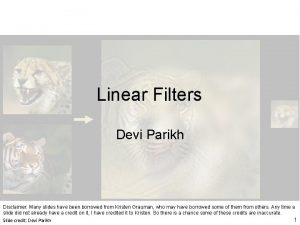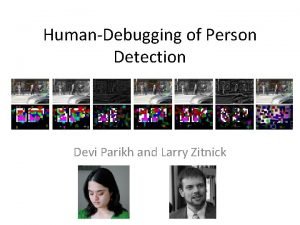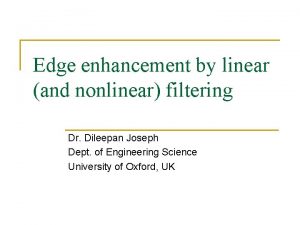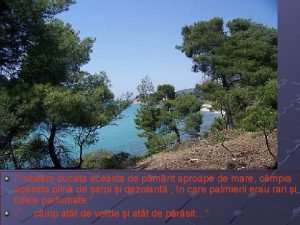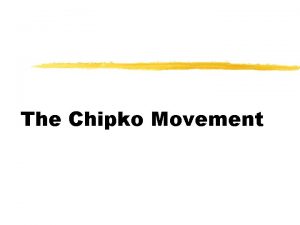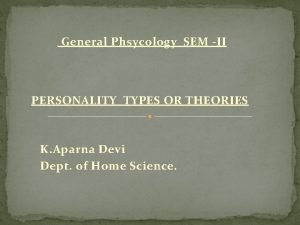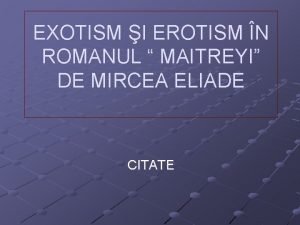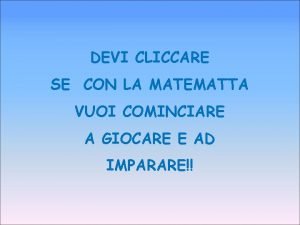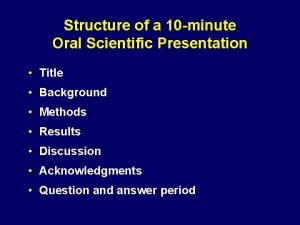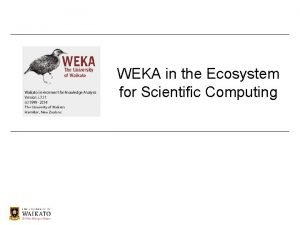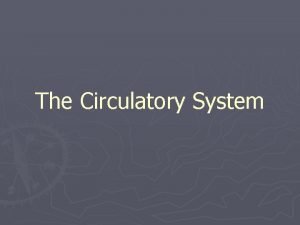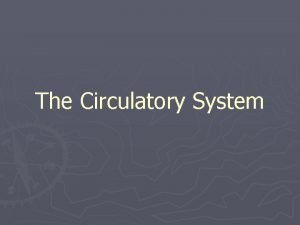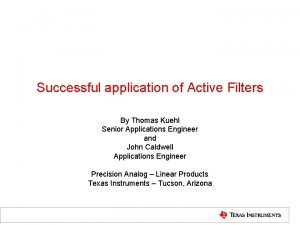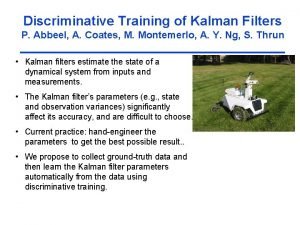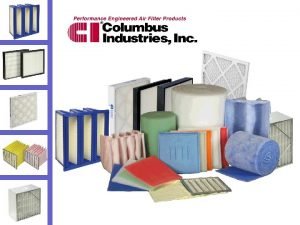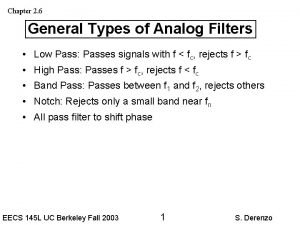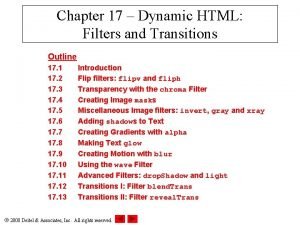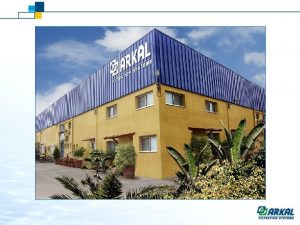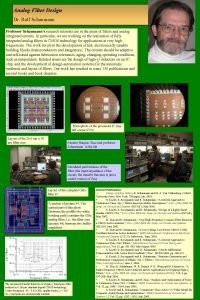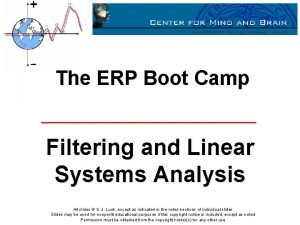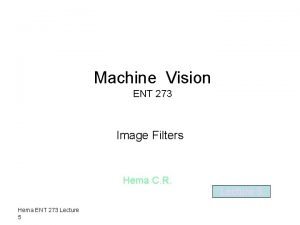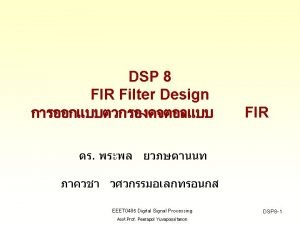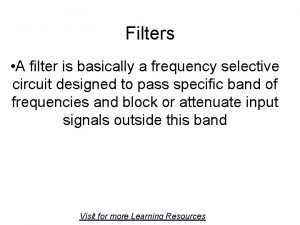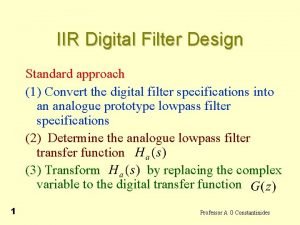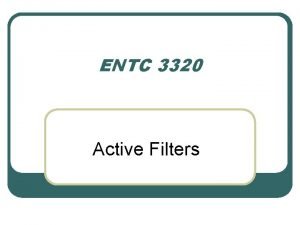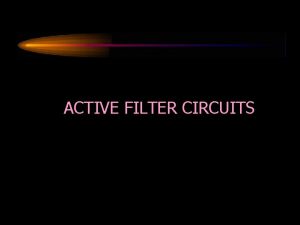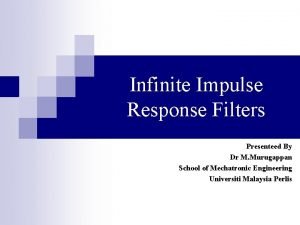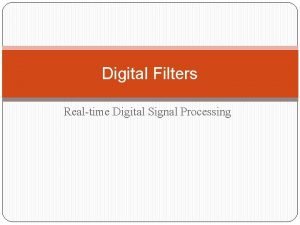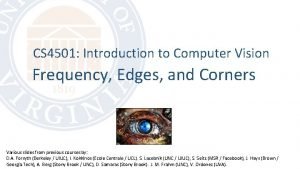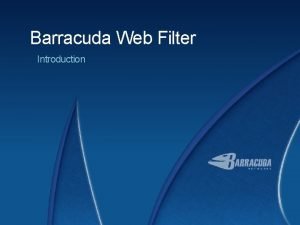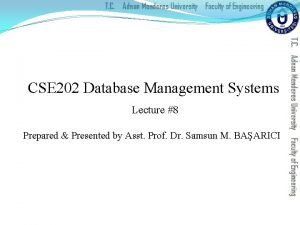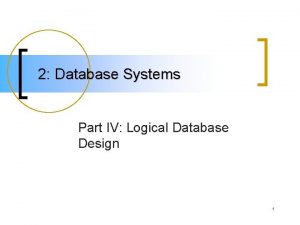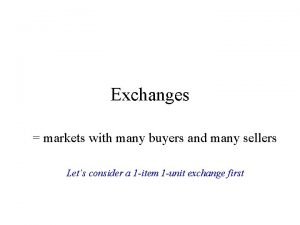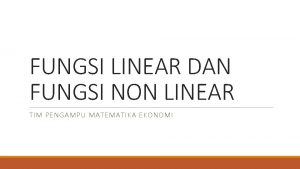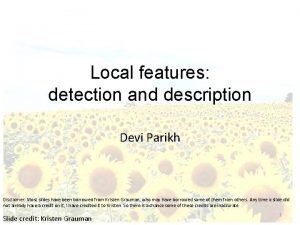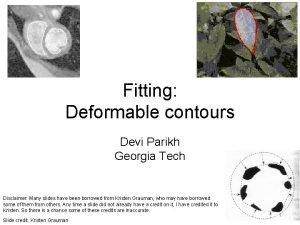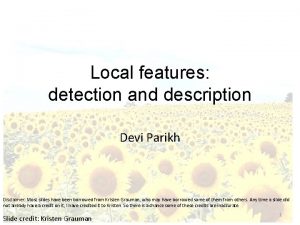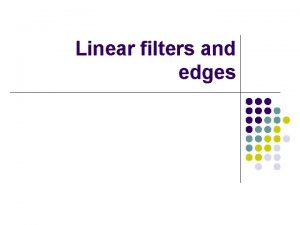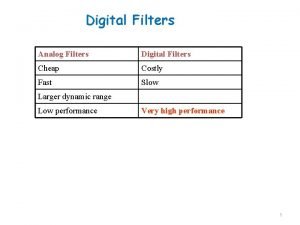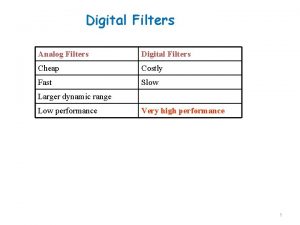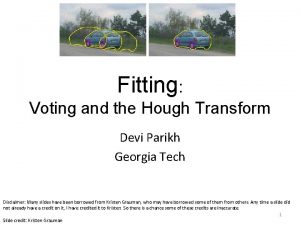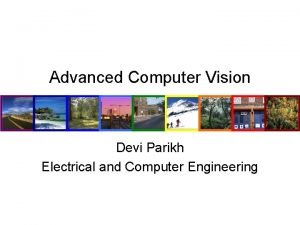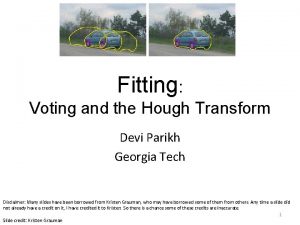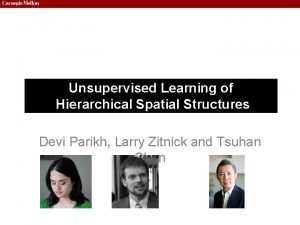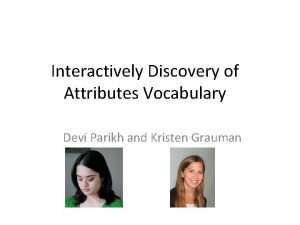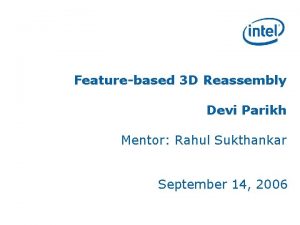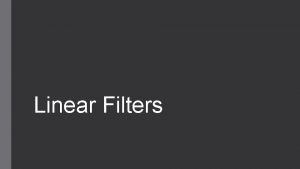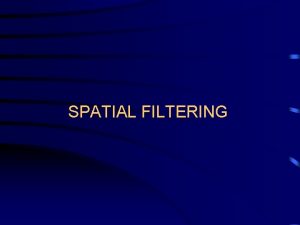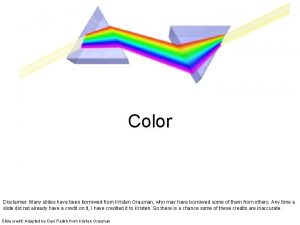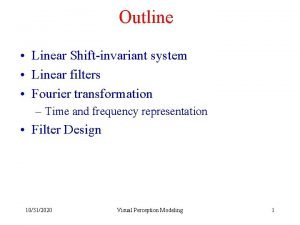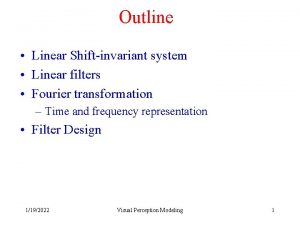Linear Filters Devi Parikh Disclaimer Many slides have






















![Weighted Moving Average Can add weights to our moving average Weights [1, 1, 1] Weighted Moving Average Can add weights to our moving average Weights [1, 1, 1]](https://slidetodoc.com/presentation_image/3c24bf3dbc04e31ace588d660ec8ce85/image-23.jpg)
![Weighted Moving Average Non-uniform weights [1, 4, 6, 4, 1] / 16 Slide credit: Weighted Moving Average Non-uniform weights [1, 4, 6, 4, 1] / 16 Slide credit:](https://slidetodoc.com/presentation_image/3c24bf3dbc04e31ace588d660ec8ce85/image-24.jpg)





















































- Slides: 77

Linear Filters Devi Parikh Disclaimer: Many slides have been borrowed from Kristen Grauman, who may have borrowed some of them from others. Any time a slide did not already have a credit on it, I have credited it to Kristen. So there is a chance some of these credits are inaccurate. 1 Slide credit: Devi Parikh

Announcements • PS 0 due Monday at 11: 58: 59 pm • Start thinking about project teams Slide credit: Devi Parikh 2

Topics overview • • • Intro Features & filters Grouping & fitting Multiple views and motion Recognition Video processing Slide credit: Kristen Grauman 3

Topics overview • • • Intro Features & filters Grouping & fitting Multiple views and motion Recognition Video processing Slide credit: Kristen Grauman 4

Topics overview • • • Intro Features & filters Grouping & fitting Multiple views and motion Recognition Video processing Slide credit: Kristen Grauman 5

Topics overview • Intro • Features & filters – Filters • • Grouping & fitting Multiple views and motion Recognition Video processing Slide credit: Kristen Grauman 6

Topics overview • Intro • Features & filters – Filters • • Grouping & fitting Multiple views and motion Recognition Video processing Neat interactive tool: http: //setosa. io/ev/image-kernels/ (thanks to Michael Cogswell) Slide credit: Kristen Grauman 7

Plan for today • Image formation • Image noise • Linear filters – Examples: smoothing filters • Convolution / correlation • Cool application: hybrid images Slide credit: Modified from Kristen Grauman 8

Image Formation Slide credit: Derek Hoiem 9

Digital camera A digital camera replaces film with a sensor array • Each cell in the array is light-sensitive diode that converts photons to electrons • http: //electronics. howstuffworks. com/digital-camera. htm Slide credit: Steve Seitz 10

Digital images • Sample the 2 D space on a regular grid • Quantize each sample (round to nearest integer) • Image thus represented as a matrix of integer values. 2 D 1 D Slide credit: Kristen Grauman, Adapted from Steve Seitz 11

Digital images Slide credit: Derek Hoiem 12

Digital color images Slide credit: Kristen Grauman 13

Digital color images Color images, RGB color space R Slide credit: Kristen Grauman G B 14

Image filtering • Compute a function of the local neighborhood at each pixel in the image – Function specified by a “filter” or mask saying how to combine values from neighbors. • Uses of filtering: – Enhance an image (denoise, resize, etc) – Extract information (texture, edges, etc) – Detect patterns (template matching) Slide credit: Kristen Grauman, Adapted from Derek Hoiem 16

Image filtering • Compute a function of the local neighborhood at each pixel in the image – Function specified by a “filter” or mask saying how to combine values from neighbors. • Uses of filtering: – Enhance an image (denoise, resize, etc) – Extract information (texture, edges, etc) – Detect patterns (template matching) Slide credit: Kristen Grauman, Adapted from Derek Hoiem 17

Motivation: noise reduction • Even multiple images of the same static scene will not be identical. Slide credit: Adapted from Kristen Grauman 18

Common types of noise – Salt and pepper noise: random occurrences of black and white pixels – Impulse noise: random occurrences of white pixels – Gaussian noise: variations in intensity drawn from a Gaussian normal distribution Slide credit: Steve Seitz 19

Gaussian noise >> noise = randn(size(im)). *sigma; >> output = im + noise; Slide credit: Kristen Grauman Figure from Martial Hebert What is impact of the sigma? 20

Motivation: noise reduction • Even multiple images of the same static scene will not be identical. • How could we reduce the noise, i. e. , give an estimate of the true intensities? • What if there’s only one image? Slide credit: Kristen Grauman 21

First attempt at a solution • Let’s replace each pixel with an average of all the values in its neighborhood • Assumptions: • Expect pixels to be like their neighbors • Expect noise processes to be independent from pixel to pixel Slide credit: Kristen Grauman 22

First attempt at a solution • Let’s replace each pixel with an average of all the values in its neighborhood • Moving average in 1 D: Slide credit: S. Marschner 23
![Weighted Moving Average Can add weights to our moving average Weights 1 1 1 Weighted Moving Average Can add weights to our moving average Weights [1, 1, 1]](https://slidetodoc.com/presentation_image/3c24bf3dbc04e31ace588d660ec8ce85/image-23.jpg)
Weighted Moving Average Can add weights to our moving average Weights [1, 1, 1] / 5 Slide credit: S. Marschner 24
![Weighted Moving Average Nonuniform weights 1 4 6 4 1 16 Slide credit Weighted Moving Average Non-uniform weights [1, 4, 6, 4, 1] / 16 Slide credit:](https://slidetodoc.com/presentation_image/3c24bf3dbc04e31ace588d660ec8ce85/image-24.jpg)
Weighted Moving Average Non-uniform weights [1, 4, 6, 4, 1] / 16 Slide credit: S. Marschner 25

Moving Average In 2 D 0 0 0 0 0 0 90 90 90 0 0 90 90 90 0 90 90 90 0 0 0 0 0 0 0 0 0 0 Slide credit: Steve Seitz 26

Moving Average In 2 D 0 0 0 0 0 0 90 90 90 0 0 90 90 90 0 90 90 90 0 0 0 0 0 0 0 0 0 0 Slide credit: Steve Seitz 0 27

Moving Average In 2 D 0 0 0 0 0 0 90 90 90 0 0 90 90 90 0 90 90 90 0 0 0 0 0 0 0 0 0 0 Slide credit: Steve Seitz 0 28

Moving Average In 2 D 0 0 0 0 0 0 90 90 90 0 0 90 90 90 0 90 90 90 0 0 0 0 0 0 0 0 0 0 Slide credit: Steve Seitz 0 10 29

Moving Average In 2 D 0 0 0 0 0 0 90 90 90 0 0 90 90 90 0 90 90 90 0 0 0 0 0 0 0 0 0 0 Slide credit: Steve Seitz 0 10 30

Moving Average In 2 D 0 0 0 0 0 0 90 90 90 0 0 90 90 90 0 90 90 90 0 0 0 0 0 0 0 0 0 0 Slide credit: Steve Seitz 0 10 20 31

Moving Average In 2 D 0 0 0 0 0 0 90 90 90 0 0 90 90 90 0 90 90 90 0 0 0 0 0 0 0 0 0 0 Slide credit: Steve Seitz 0 10 20 32

Moving Average In 2 D 0 0 0 0 0 0 90 90 90 0 0 90 90 90 0 90 90 90 0 0 0 0 0 0 0 0 0 0 Slide credit: Steve Seitz 0 10 20 30 33

Moving Average In 2 D 0 0 0 0 0 0 90 90 90 0 0 90 90 90 0 90 90 90 0 0 0 0 0 0 0 0 0 0 Slide credit: Steve Seitz 0 10 20 30 34

Moving Average In 2 D 0 0 0 0 0 0 90 90 90 0 0 90 90 90 0 90 90 90 0 0 0 0 0 0 0 0 0 0 Slide credit: Steve Seitz 0 10 20 30 30 35

Moving Average In 2 D 0 0 0 0 0 0 10 20 30 30 30 20 10 0 90 90 90 0 20 40 60 60 60 40 20 0 90 90 90 0 30 60 90 90 90 60 30 0 90 90 90 0 30 50 80 80 90 60 30 0 90 90 90 0 20 30 50 50 60 40 20 0 0 10 20 30 30 20 10 0 0 90 0 0 0 10 10 10 0 0 0 Slide credit: Steve Seitz 36

Correlation filtering Say the averaging window size is 2 k+1 x 2 k+1: Attribute uniform weight to each pixel Loop over all pixels in neighborhood around image pixel F[i, j] Now generalize to allow different weights depending on neighboring pixel’s relative position: Non-uniform weights Slide credit: Kristen Grauman 37

Correlation filtering This is called cross-correlation, denoted Filtering an image: replace each pixel with a linear combination of its neighbors. The filter “kernel” or “mask” H[u, v] is the prescription for the weights in the linear combination. Slide credit: Kristen Grauman 38

Averaging filter • What values belong in the kernel H for the moving average example? 0 0 0 0 0 0 90 90 90 0 0 90 90 90 0 90 90 90 0 0 0 0 0 0 0 0 0 0 Slide credit: Kristen Grauman 1 1 1 0 10 20 30 30 ? 1 1 1 “box filter” 39

Smoothing by averaging depicts box filter: white = high value, black = low value original filtered What if the filter size was 5 x 5 instead of 3 x 3? Slide credit: Kristen Grauman 40

Boundary issues What is the size of the output? • MATLAB: output size / “shape” options • shape = ‘full’: output size is sum of sizes of f and g • shape = ‘same’: output size is same as f • shape = ‘valid’: output size is difference of sizes of f and g full g g same g f g Slide credit: Svetlana Lazebnik valid g g f g g g 41

Boundary issues What about near the edge? • the filter window falls off the edge of the image • need to extrapolate • methods: – – Slide credit: S. Marschner clip filter (black) wrap around copy edge reflect across edge 42

Boundary issues What about near the edge? • the filter window falls off the edge of the image • need to extrapolate • methods (MATLAB): – – Slide credit: S. Marschner clip filter (black): wrap around: copy edge: reflect across edge: imfilter(f, g, 0) imfilter(f, g, ‘circular’) imfilter(f, g, ‘replicate’) imfilter(f, g, ‘symmetric’) 43

Gaussian filter • What if we want nearest neighboring pixels to have the most influence on the output? 0 0 0 0 0 0 90 90 90 0 0 90 90 90 0 90 90 90 0 0 0 0 0 0 0 0 0 0 This kernel is an approximation of a 2 d Gaussian function: 1 2 4 2 1 • Removes high-frequency components from the image (“low-pass filter”). Slide credit: Steve Seitz 44

Smoothing with a Gaussian Slide credit: Kristen Grauman 45

Gaussian filters • What parameters matter here? • Size of kernel or mask – Note, Gaussian function has infinite support, but discrete filters use finite kernels σ = 5 with 10 x 10 kernel Slide credit: Kristen Grauman σ = 5 with 30 x 30 kernel 46

Gaussian filters • What parameters matter here? • Variance of Gaussian: determines extent of smoothing σ = 2 with 30 x 30 kernel Slide credit: Kristen Grauman σ = 5 with 30 x 30 kernel 47

Matlab >> hsize = 10; >> sigma = 5; >> h = fspecial(‘gaussian’, hsize, sigma); >> mesh(h); >> imagesc(h); >> outim = imfilter(im, h); % correlation >> imshow(outim); Slide credit: Kristen Grauman outim 48

Smoothing with a Gaussian Parameter σ is the “scale” / “width” / “spread” of the Gaussian kernel, and controls the amount of smoothing. … Slide credit: Kristen Grauman for sigma=1: 3: 10 h = fspecial('gaussian‘, hsize, sigma); out = imfilter(im, h); imshow(out); pause; end 49

Properties of smoothing filters • Smoothing – – Values positive Sum to 1 constant regions same as input Amount of smoothing proportional to mask size Remove “high-frequency” components; “low-pass” filter Slide credit: Kristen Grauman 50

Filtering an impulse signal What is the result of filtering the impulse signal (image) F with the arbitrary kernel H? 0 0 0 0 0 0 1 0 0 0 0 0 0 Slide credit: Kristen Grauman a b c d e f g h i ? 51

Convolution • Convolution: – Flip the filter in both dimensions (bottom to top, right to left) – Then apply cross-correlation F Notation for convolution operator Slide credit: Kristen Grauman H 52

Convolution vs. correlation Convolution Cross-correlation For a Gaussian or box filter, how will the outputs differ? If the input is an impulse signal, how will the outputs differ? Slide credit: Kristen Grauman 53

Predict the outputs using correlation filtering * 0 0 1 0 0 =? * Slide credit: Kristen Grauman 0 0 2 0 0 * - 1 1 1 1 1 0 0 0 =? 54

Practice with linear filters 0 0 1 0 0 ? Original Slide credit: David Lowe 55

Practice with linear filters 0 0 1 0 0 Original Slide credit: David Lowe Filtered (no change) 56

Practice with linear filters 0 0 0 1 0 0 0 ? Original Slide credit: David Lowe 57

Practice with linear filters 0 0 0 1 0 0 0 Original Slide credit: David Lowe Shifted left by 1 pixel with correlation 58

Practice with linear filters 1 1 1 1 1 ? Original Slide credit: David Lowe 59

Practice with linear filters 1 1 1 1 1 Original Slide credit: David Lowe Blur (with a box filter) 60

Practice with linear filters 0 0 2 0 0 - 1 1 1 1 1 ? Original Slide credit: David Lowe 61

Practice with linear filters 0 0 2 0 0 Original Slide credit: David Lowe - 1 1 1 1 1 Sharpening filter: accentuates differences with local average 62

Filtering examples: sharpening Slide credit: Kristen Grauman 63

Properties of convolution • Shift invariant: – Operator behaves the same everywhere, i. e. the value of the output depends on the pattern in the image neighborhood, not the position of the neighborhood. • Superposition: – h * (f 1 + f 2) = (h * f 1) + (h * f 2) Slide credit: Kristen Grauman 64

Properties of convolution • Commutative: f*g=g*f • Associative (f * g) * h = f * (g * h) • Distributes over addition f * (g + h) = (f * g) + (f * h) • Scalars factor out kf * g = f * kg = k(f * g) • Identity: unit impulse e = […, 0, 0, 1, 0, 0, …]. f * e = f Slide credit: Kristen Grauman 65

Separability • In some cases, filter is separable, and we can factor into two steps: – Convolve all rows – Convolve all columns Slide credit: Kristen Grauman 66

Separability • In some cases, filter is separable, and we can factor into two steps: e. g. , h What is the computational complexity advantage for a separable filter of size k x k, in terms of number of operations per output pixel? g f f * (g * h) = (f * g) * h Slide credit: Kristen Grauman 67

Effect of smoothing filters Additive Gaussian noise Slide credit: Kristen Grauman Salt and pepper noise 68

Median filter • No new pixel values introduced • Removes spikes: good for impulse, salt & pepper noise • Non-linear filter Slide credit: Kristen Grauman 69

Median filter Salt and pepper noise Median filtered Plots of a row of the image Slide credit: Martial Hebert Matlab: output im = medfilt 2(im, [h w]); 70

Median filter • Median filter is edge preserving Slide credit: Kristen Grauman 71

Filtering application: Hybrid Images Slide credit: Kristen Grauman Aude Oliva & Antonio Torralba & Philippe G Schyns, SIGGRAPH 200672

Application: Hybrid Images Gaussian Filter A. Oliva, A. Torralba, P. G. Schyns, “Hybrid Images, ” SIGGRAPH 2006 Laplacian Filter unit impulse Slide credit: Kristen Grauman Gaussian Laplacian of Gaussian 73

Slide credit: Kristen Grauman Aude Oliva & Antonio Torralba & Philippe G Schyns, SIGGRAPH 200674

Slide credit: Kristen Grauman Aude Oliva & Antonio Torralba & Philippe G Schyns, SIGGRAPH 200675

Summary • Image formation • Image “noise” • Linear filters and convolution useful for – Enhancing images (smoothing, removing noise) • Box filter • Gaussian filter • Impact of scale / width of smoothing filter – Detecting features (next) • Separable filters more efficient • Median filter: a non-linear filter, edge-preserving Slide credit: Kristen Grauman 76

Topics overview • Intro • Features & filters – Filters – Gradients – Edges • • Grouping & fitting Multiple views and motion Recognition Video processing Slide credit: Kristen Grauman 77

Questions?
 Vqa
Vqa Devi parikh
Devi parikh Devi
Devi Capitalideasonline
Capitalideasonline Difference between linear and nonlinear spatial filters
Difference between linear and nonlinear spatial filters A small child slides down the four frictionless slides
A small child slides down the four frictionless slides A crane lowers a girder into place at constant speed
A crane lowers a girder into place at constant speed Io devo tu devi
Io devo tu devi Mahasweta devi the hunt
Mahasweta devi the hunt Ma leg de tine pamantule
Ma leg de tine pamantule Gaura devi
Gaura devi Aditi devi bhava
Aditi devi bhava Devi pratami
Devi pratami Om prano devi saraswati mantra
Om prano devi saraswati mantra Khiloni devi dharamshala pitampura
Khiloni devi dharamshala pitampura Devi personality type
Devi personality type Dr. r. latha devi
Dr. r. latha devi Citate din maitreyi
Citate din maitreyi Se la terra vuoi salvare ogni giorno ti devi impegnare
Se la terra vuoi salvare ogni giorno ti devi impegnare Matematta
Matematta Language planning
Language planning 8 vertices and 12 edges.
8 vertices and 12 edges. How many slides for a 10 minute presentation
How many slides for a 10 minute presentation Etching cleaning process
Etching cleaning process Filters in weka
Filters in weka Where is the heart located
Where is the heart located Lymph nodes: “filters of the blood”
Lymph nodes: “filters of the blood” Applications of active filters
Applications of active filters Ironport outbreak filters
Ironport outbreak filters Discriminative training of kalman filters
Discriminative training of kalman filters Columbus industries
Columbus industries Types of analog filters
Types of analog filters Filters and transitions in dhtml
Filters and transitions in dhtml Disc filters galaxy 4 spin klin series
Disc filters galaxy 4 spin klin series Hailstop hail guard
Hailstop hail guard Rolf schaumann
Rolf schaumann Impulse erp
Impulse erp Hema filter
Hema filter ำ
ำ Content uniformity test for parenterals
Content uniformity test for parenterals Our personal filters assumptions
Our personal filters assumptions Frequency selective filters
Frequency selective filters Opinion vs argument
Opinion vs argument Joint legacy
Joint legacy Spectral transformation of iir filters
Spectral transformation of iir filters Advantages of active filters
Advantages of active filters Active vs passive filter
Active vs passive filter Bacterial filters ppt
Bacterial filters ppt Perceptual filters
Perceptual filters Emfab filters
Emfab filters Compare analog and digital filters
Compare analog and digital filters Digital image processing
Digital image processing Authentication filters in mvc 5
Authentication filters in mvc 5 Xss filter bypass
Xss filter bypass Event list filters packet tracer
Event list filters packet tracer Skimage.filters.gaussian
Skimage.filters.gaussian Barracuda web filters
Barracuda web filters Many sellers many buyers
Many sellers many buyers Er diagram
Er diagram Bookstore database design
Bookstore database design Difference between erm and erd
Difference between erm and erd Unary many to many
Unary many to many Erd film
Erd film Unary many to many
Unary many to many Many to many communication
Many to many communication Sqlbi many to many
Sqlbi many to many Unary many to many
Unary many to many Many sellers and many buyers
Many sellers and many buyers Simple and multiple linear regression
Simple and multiple linear regression Contoh soal persamaan non linier metode biseksi
Contoh soal persamaan non linier metode biseksi Non-linear text
Non-linear text Non linear plot example
Non linear plot example Contoh soal metode tabel
Contoh soal metode tabel Linear vs nonlinear pipelining
Linear vs nonlinear pipelining Media classification
Media classification Right linear to left linear grammar
Right linear to left linear grammar Perbedaan fungsi linier dan non linier
Perbedaan fungsi linier dan non linier Jelaskan apa yang dimaksud dengan fungsi non linear??
Jelaskan apa yang dimaksud dengan fungsi non linear??

